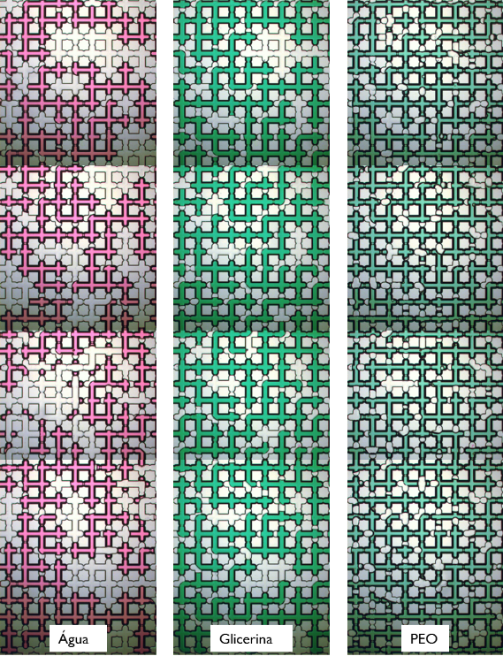Complex fluids, such as polymer solutions and dispersions, are frequently injected for well conformance and as an enhanced oil recovery method. The research being developed in this area is focused on understanding the fundamentals of flow of complex liquids, such as viscoelastic polymer solutions, oil-water emulsions and suspension of flexible microcapsules, in porous media and their application as EOR agent.
We combine core-flooding experiments, pore-scale flow visualization using optical and confocal microscopy and x-ray micro tomography, capillary network model and continuous model to understand these complex flows and how the microscopic phenomena relate to the observed macroscopic flow behavior.
Recent and current research projects:
Condensate gas flow through porous media
Liquid dropout and retention in gas-condensate reservoirs, especially in the near wellbore region, obstruct gas flowing paths and impact negatively the produced fluid volume and composition. Yet, condensate banking forecasting is commonly inaccurate, as experiments seldom reproduce reservoir extreme conditions and complex fluid composition, while most pore-scale models over-simplify the physics of phase transitions between gas and condensate. We study condensate gas flow using a compositional pore network model, microscale visualization and core flooding experiments.
The pore network mode is able to reproduce relative permeability curves obtained experimentally without any fitting parameter and to study different methods to enhance gas and condensate recovery.
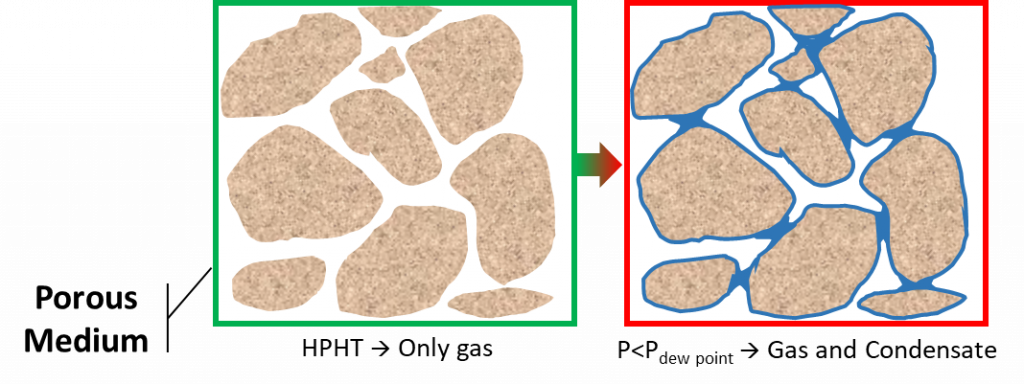
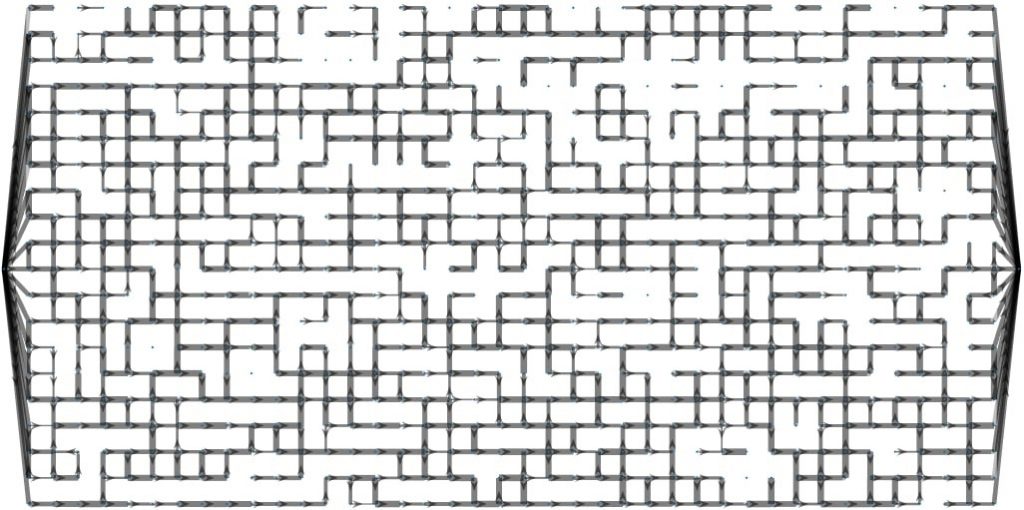
Recent Publications:
- P. K. P. Reis e M. S. Carvalho, “Compositional Pore-Newtwork Modeling of Gas-Condensate Flow: Effect of Interfacial Tension and Flow Velocity”, submitted for publication International Journal of Multiphase Flow, 2020.
- M. P. C. Santos e M. S. Carvalho, “Pore network model for retrograde gas flow in porous media”, Journal of Petroleum Science and Engineering, vol. 185, 106635, 2020.
Flow of dispersions as an enhanced oil recovery method
Early field tests have shown the potential of emulsion flooding for EOR. Application of emulsion injection for increasing sweep efficiency has been reported in the literature. One difficulty in designing an EOR process based on emulsion flooding lies on having a better understanding of the displacement mechanisms in porous media. Established filtration models fail to accurately predict the transport process of these complex fluids in a porous medium, including the observed pressure drops and recovery factors.
We study emulsion injection by pore scale visualization, core flooding experiments, pore network model and reservoir scale modeling. This research is being extended to flow of suspensions of flexible microcapsules.
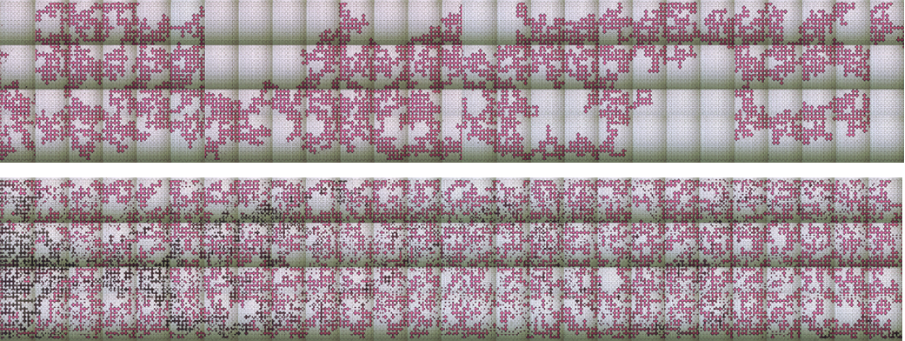
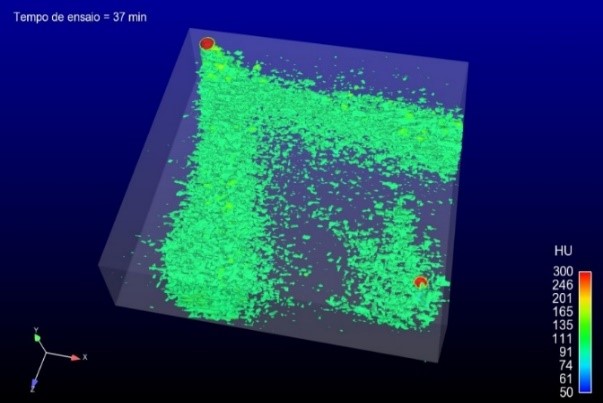

Recent Publications:
- R. V. Ponce, V. Alvarado e M. S. Carvalho, “Water-alternating-macro emulsion reservoir simulation through capillary-number dependent modeling”, Journal of the Brazilian Society of Mechanical Sciences and Engineering, vol.39(10), 4135-4145, 2017
- M. L. R. Farias, E. F. Campos, A. L. S. Souza e M. S. Carvalho, “Injection of Dilute Oil-in-Water Emulsion as an Enhanced Oil Recovery Method for Heavy Oil: 1D and 3D Flow Configurations”, Transport in Porous Media, vol.113, 267–281, 2016.
- R. V. Flores, V. Alvarado and M. S. Carvalho, “Oil recovery modeling of macro emulsion flooding at low capillary number”, Journal of Petroleum Science and Engineering. vol.119, pp. 112 – 122, 2014.
- B. Engelke, M. S. Carvalho e V. Alvarado, “Conceptual Darcy-Scale Model of Oil Displacement with Macro Emulsion”, Energy and Fuels, vol. 27(4), 1967-1973, 2013.
- V. R. Guillen, M. S. Carvalho e V. Alvarado, “Pore-scale and macroscopic displacement mechanisms in emulsion flooding”, Transport in Porous Media, vol.94, 197 – 206, 2012.
- V. R. Guillen, M. I. Romero, M. S. Carvalho e V. Alvarado, “Capillary-driven mobility control in macro emulsion flow in porous media”, International Journal of Multiphase Flow, vol.43, 62-65, 2012.
- M. I. Romero, M. S. Carvalho e V. Alvarado, “Experiments and Network Model of Flow of Oil-water Emulsion in Porous Media”, Physical Review E, vol.84(4), 046305, 2011.
Oil Displacement by Polymer Injection
Polymer solution injection is used in the industry as an alternative to water injection. The common wisdom is that the higher viscosity reduces the mobility of the water phase and improves the amount of oil displaced. However, polymer solutions may present viscoelastic behavior that can change the pore scale flow, reducing the residual oil saturation of areas swept by the water phase. The fundamental understanding of the pore level effect is still not well established and is being studied by pore scale visualization and core flooding experiments.
